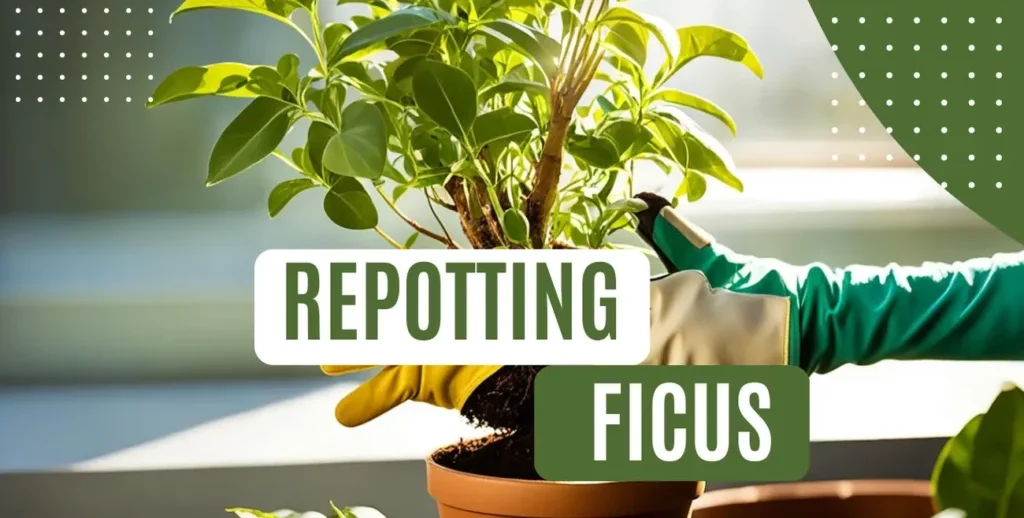To repot Ficus plants for healthy growth, gently remove the plant from its current pot, prune any dead roots, place it in a slightly larger pot with fresh potting soil, and water thoroughly.
This guide will walk you through the crucial steps of repotting your Ficus to maintain its lush foliage and robust health. We’ll cover everything from the significance of repotting, selecting the appropriate pot, to the actual process and aftercare, ensuring your Ficus thrives.
Let’s explore the optimal way to provide your Ficus with a nurturing environment through effective repotting practices.
Why is Ficus Repotting Important?

In this section, I will explain the importance of repotting your Ficus plant. Repotting plays a vital role in the overall health and well-being of your Ficus. It is crucial to ensure that your plant continues to thrive and flourish.
Repotting prevents your Ficus from becoming root-bound, where the roots outgrow the pot and become overcrowded. When the roots are cramped, they can’t absorb nutrients effectively, leading to stunted growth and poor foliage health.
By repotting, you provide your Ficus with ample space for its roots to spread and establish a robust root system.
Proper repotting allows for better nutrient absorption. Over time, the soil in the pot becomes depleted of essential nutrients. By repotting your Ficus, you can replenish the soil with fresh, nutrient-rich potting mix, providing the necessary fuel for optimal growth.
Moreover, repotting promotes healthy root development. As your Ficus continues to grow, its roots also grow and expand. Repotting allows you to inspect the root system and trim any damaged or tangled roots.
This pruning stimulates the growth of new, healthy roots, enhancing the overall health of the plant.
Another benefit of repotting is that it ensures adequate space for growth. As your Ficus matures, it requires a larger pot to accommodate its increasing size.
Repotting provides the necessary room for your plant to thrive, allowing its roots to spread and absorb water and nutrients more effectively.
By understanding the importance of repotting your Ficus plant, you can ensure that it continues to flourish and enhance the aesthetics of your indoor space.
It is an essential part of your regular plant care routine, contributing to the long-term health and vitality of your Ficus.
- Prevents root-bound growth
- Ensures better nutrient absorption
- Promotes healthy root development
- Provides adequate space for growth
When to Repot Your Ficus

Timing plays a crucial role in the successful repotting of your Ficus plant. Recognizing the signs that indicate your plant needs repotting and understanding the best time to carry out this task are essential for its long-term health and growth.
So, how can you determine when it’s time to repot your Ficus? Look for these signs:
- Roots circling the pot’s surface or protruding through drainage holes
- Slow or stunted growth despite adequate care
- Excessive drying out of the potting mix
Observing these cues lets you know that your Ficus is ready for a new, roomier home.
Equally important is knowing the best time of the year to repot your Ficus. Generally, the spring months, from March to May, are ideal for repotting.
During this time, your Ficus is entering its active growth phase, which means it can recover more quickly from the stress of repotting.
Choosing the Right Pot for Your Ficus

When it comes to repotting your Ficus, selecting the right pot is crucial for its overall health and vitality. In this section, I will guide you on how to make the best pot selection for your Ficus plant, ensuring it has the appropriate pot size, material, and style to thrive.
Pot Size and Capacity
Choosing the correct pot size is essential to provide adequate root space for your Ficus. A pot that is too small can restrict root growth and lead to overcrowding, while a pot that is too large can result in excessive moisture retention and potential root rot.
As a general rule, select a pot that allows for about an inch of additional space around the rootball.
- For small Ficus plants or seedlings, opt for a pot with a diameter of 4 to 6 inches.
- Medium-sized Ficus plants will thrive in pots with a diameter of 8 to 10 inches.
- Large Ficus plants require pots with a diameter of 12 inches or more.
Material and Style
When it comes to the material and style of the pot, you have several options to choose from. Clay pots, also known as terracotta pots, are a popular choice for Ficus plants as they provide good drainage and allow the soil to breathe.
They also offer stability and prevent top-heavy plants from tipping over.
Another option is plastic pots, which are lightweight and retain moisture well. Plastic pots are a great choice if you live in a dry climate or tend to forget watering your plants from time to time.
Lastly, ceramic pots are an attractive option that adds aesthetic appeal to your Ficus plant display. However, keep in mind that ceramic pots are not as breathable as clay pots and may require extra attention to watering and drainage.
Drainage Considerations
Proper drainage is crucial for the health of your Ficus plant. When selecting a pot, ensure it has drainage holes at the bottom to allow excess water to escape.
Additionally, consider placing a layer of gravel or small rocks at the bottom of the pot before adding the soil. This will help prevent water from pooling around the roots and potentially causing root rot.
Now that you know the key factors to consider when selecting a pot for your Ficus plant, you can confidently choose the perfect pot that meets its size, material, and drainage needs. Next, we will delve into the essential steps to prepare your Ficus for repotting.
Preparing Your Ficus for Repotting

Before repotting your Ficus, it’s important to adequately prepare your plant for the process. Taking a few simple steps beforehand will help ensure a successful repotting experience and promote the health of your Ficus.
Here are the key steps to follow:
- Watering: About a week before repotting, water your Ficus thoroughly to hydrate the roots and make them easier to work with. Avoid overwatering to prevent excessive moisture in the soil.
- Trimming: Trim any long, unruly roots or remove dead and damaged foliage before repotting. This will encourage healthy growth and prevent the plant from becoming top-heavy.
- Inspecting: Carefully inspect your Ficus for any signs of diseases or pests. Look for yellowing leaves, spots, or unusual growth patterns. If you notice any issues, take appropriate measures to address them before proceeding with repotting.
Step-by-Step Ficus Repotting Process

Are you ready to give your Ficus plant a fresh start? In this section, I’ll guide you through the step-by-step process of repotting your Ficus, ensuring its continued growth and vitality.
1. Gather Your Supplies
Before beginning the repotting process, gather all the necessary supplies:
- A new pot that is one size larger than the current pot.
- High-quality potting soil.
- A trowel or gardening shovel.
- A watering can or spray bottle.
2. Prepare the New Pot
Ensure the new pot has drainage holes to prevent waterlogging. Fill the pot with fresh potting soil, leaving enough space at the top to accommodate the Ficus plant.
3. Carefully Remove the Ficus from its Current Pot
Gently turn the plant upside down, supporting the base with one hand. Tap the bottom of the pot to loosen the soil, then carefully slide the Ficus out.
4. Loosen the Roots and Inspect for Health
Use your fingers to carefully loosen the roots. Remove any dead or damaged roots with clean, sharp scissors. Inspect the remaining roots for signs of diseases or pests.
5. Transfer the Ficus to the New Pot
Place the Ficus into the new pot, ensuring it is centered and at the appropriate depth. Add more potting soil around the sides, gently firming it down to provide support.
6. Water and Settle the Soil
Thoroughly water the Ficus until the excess water drains out of the bottom. This helps settle the soil and ensures proper hydration for the plant.
7. Find the Perfect Spot
Choose a spot for your repotted Ficus where it can receive the appropriate amount of light and temperature. Avoid placing it in direct sunlight or near drafts.
8. Monitor and Care for Your Repotted Ficus
After repotting, closely monitor your Ficus for the next few weeks. Adjust your watering and fertilizing routine as needed and provide the plant with the care it requires for optimal growth.
Aftercare Tips for Repotted Ficus

Now that you have successfully repotted your Ficus, it’s important to provide the right aftercare to ensure its continued health and vitality. Follow these essential tips to support your repotted Ficus in thriving conditions:
- Watering Routines: Maintain a consistent watering schedule for your Ficus. Water thoroughly when the top inch of soil feels dry to the touch, allowing excess water to drain away.
- Appropriate Lighting Conditions: Find a bright spot for your Ficus that receives indirect sunlight. Avoid placing it in direct sunlight, as it can scorch the leaves.
- Potential Fertilizer Requirements: Feed your Ficus with a balanced houseplant fertilizer during the growing season. Follow the instructions on the fertilizer packaging for proper application.
- Monitoring for Signs of Stress or Complications: Keep a close eye on your repotted Ficus for any signs of stress, such as yellowing leaves, drooping foliage, or insect infestation. Address any issues promptly to prevent further damage.
Troubleshooting Common Issues After Repotting

Occasionally, after repotting your Ficus plant, you may encounter some common issues that can affect its health and growth. In this section, I will address these issues and provide you with a troubleshooting guide to help you identify and resolve them.
1. Root Rot: Root rot is a fungal disease that can occur when the roots of your Ficus are consistently overwatered. This can lead to yellowing leaves, wilted foliage, and an unpleasant odor.
To address root rot, carefully remove the plant from the pot, trim away any affected roots, and replant it in fresh, well-draining soil.
2. Overwatering: Overwatering is a common mistake that can cause root rot and other issues. If you notice waterlogged soil, wilting foliage, or yellowing leaves, it’s a sign of overwatering.
Allow the soil to dry out between each watering session and adjust your watering schedule accordingly.
3. Under-watering: On the other hand, under-watering can cause your Ficus to become dehydrated and display symptoms such as drooping leaves and dry soil.
Be mindful of the moisture level in the soil and water your plant when the top inch feels dry to the touch.
4. Leaf Drop: Leaf drop is a common response to stress in Ficus plants, and repotting can sometimes cause temporary stress. If you notice excessive leaf dropping, ensure your Ficus is receiving adequate light, water, and humidity.
It’s normal for your plant to shed some leaves during the adjustment period.
5. Lack of Growth: If your Ficus doesn’t show signs of new growth after repotting, it may be due to inadequate light, improper watering, or lack of nutrients.
Ensure your plant is placed in a well-lit area, follow a consistent watering routine, and consider adding a balanced fertilizer to provide the necessary nutrients.
Final Thoughts on Ficus Repotting

As a final tip, it’s important to monitor your Ficus plant after repotting for any signs of stress or complications. Keep an eye out for changes in leaf color, unusual growth patterns, or wilting.
Adjust watering routines as needed and ensure your Ficus receives adequate sunlight to support its growth.
By providing your Ficus with the optimal growing conditions, regular repotting, and necessary aftercare, you can enjoy the rewards of a thriving houseplant.
Remember that each Ficus plant is unique, so be observant and adaptable to its specific needs. With proper care and attention, your Ficus will continue to bring beauty and life to your indoor space for years to come.







